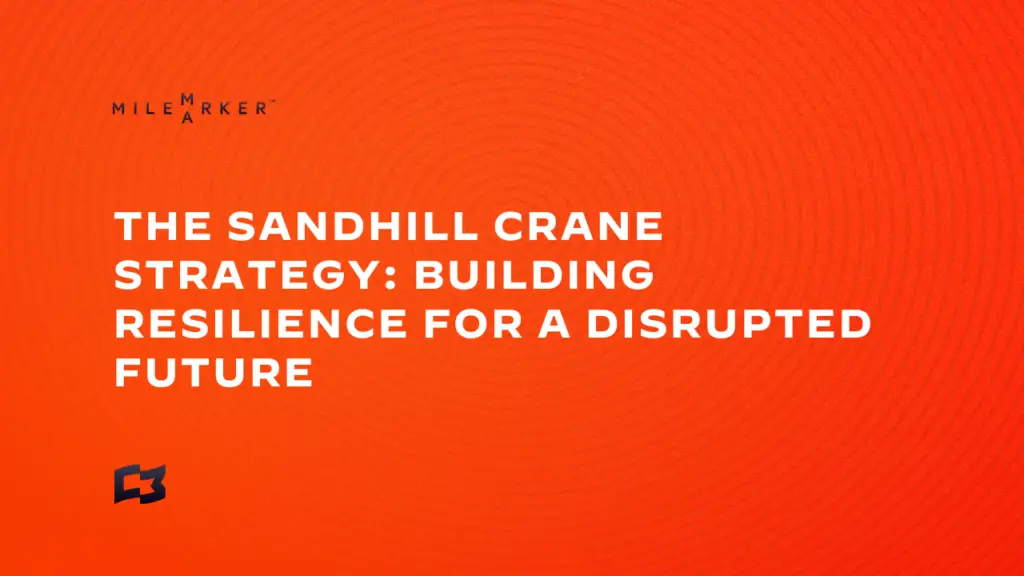The Sandhill Crane Strategy for Business Resilience Amid Disruption

This past Sunday, I had some time to kill between my daughter’s orchestra events in Central Florida and a client conference in Tampa.
So I set out for a 7-mile walk before the heat kicked in.
A few miles in, I encountered an unexpected obstacle: Sandhill Cranes.
Not one or two — but family clusters, crossing the roads at their own deliberate pace.
Bicyclists pushing hard to hit their mileage goals, drivers rushing to church — everyone hit the brakes.
We all made way for the cranes.
These birds are almost prehistoric in how they move — towering, slow, and utterly unfazed by everything around them.
Not All Cranes Are the Same — And Neither Are Businesses
Around the world, Sandhill Cranes are famous for their epic migrations — traveling thousands of miles each year across North America and even into Siberia.
Their patterns stretch across continents, moving with the seasons, enduring incredible hardship to find the right conditions to thrive.
But here in Central Florida, it’s different.
Florida is home to a strong population of non-migratory Sandhill Cranes.
They live here year-round.
They don’t migrate when things get tough.
They’ve adapted to the climate, to the development, and to the changing environment — raising their young and building a life in a place that demands constant resilience.
There’s a lesson here.
Not every business is built to move with the seasons.
Some are migratory — shifting strategies, able and willing to pivot when the winds change.
Others are like Florida’s cranes — digging deeper, adapting in place, enduring even as everything around them shifts.
Neither approach is wrong.
But knowing which kind of resilience you need — mobility or rootedness — is essential for surviving disruption.
Disruption Isn’t Optional
All of our businesses are going to get hit.
It’s not a question of if. It’s when.
And the businesses that thrive through disruption are the ones that understand how to work it out — how to plan for and weather change instead of getting caught off guard by it.
We’re living through one of the most disruptive periods in human history.
Economics, politics, technology, culture — everything is being tested.
And it won’t all look the same in the very near future.
So how do we build resilience?
How do we lead through it?
Here’s what I’m focusing on right now — and what I believe every leader should consider too:
1. Stay obsessively connected to your clients’ real outcomes.
Not just once a year.
Not just about your current engagement.
Get to know the whole story of your clients — their careers, their businesses, their families, their dreams.
If you lose the thread of what truly matters to your clients, everything else eventually falls apart.
Action:
– Schedule regular deep-dive conversations.
– Listen harder than you sell.
2. Experiment thoughtfully and consistently.
Innovation does not require massive budgets or years long timelines.
You can prompt an AI model instead of hiring a consultant.
You can run a $50 ad test instead of building a full campaign.
Experimentation is cheaper, faster, and more important than ever.
Of course, you don’t need to productize every new idea, but you do need to stretch yourself into new areas that matter to your clients.
Action:
– Try one small experiment every month — even if it’s just for learning.
3. Train your team to welcome change.
The future is scary.
But if your team is afraid of it, you’re finished.
You need people who lean into change, not away from it.
Not everyone will.
Some will opt out — usually not with their hands, but with their feet.
And that’s okay.
But you have to keep building a culture where ambition, curiosity, and resilience are expected.
Action:
– Normalize change by asking change related questions of your team: ‘How will that change how we operate? What needs to change in how we think about this? What kind of change can we anticipate in this area?’ Naming helps make it normal.
– Celebrate it. Put time on the company calendar to mark the change so that it becomes part of the culture.
The World Will Keep Changing. So Must We.
The cranes don’t apologize for crossing the road. They just move forward at their own desired pace.
The world will keep changing around us, at it’s own pace. Our job — as leaders, as builders, as people trying to create something that lasts — is to help make our team isn’t scared or confused while they cross the road too.
Resilient businesses don’t just survive disruption.
They become stronger because of it.
Just like the cranes.
